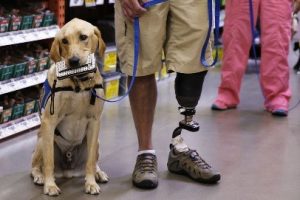 Service dogs – a very hot topic on the civil rights listservs I read. In this article I will share some resources to help you understand the difference between a service dog and an emotional support animal and which is allowed in the classroom.
Service dogs – a very hot topic on the civil rights listservs I read. In this article I will share some resources to help you understand the difference between a service dog and an emotional support animal and which is allowed in the classroom.
Who doesn’t like a good definition or two to get things rolling? The definition of a service dog according to the Americans with Disabilities Act FAQ page on Service Dogs is “Under the ADA, a service animal is defined as a dog that has been individually trained to do work or perform tasks for an individual with a disability. The task(s) performed by the dog must be directly related to the person’s disability.” These animals and their handler fall under the protection of the ADA and must be allowed in public places.
That same document tells us that an emotional support/comfort animal is not individually trained to perform a specific task. They bring comfort to a person just by their presence and do not qualify for protection under the ADA. They are not allowed in public places.
When working with a student who brings a dog to class it can be difficult to know in which category that dog fits. There is legal guidance on what questions we can ask the student so we avoid crossing over into discriminatory language. The questions we are allowed to ask a student who has a dog on campus are: (1) Is that a dog that has been trained to provide a service directly related to your disability? (2) What work or task has the dog been trained to provide?
Notice that #1 asks if the dog is already trained. Dogs in training do not qualify for ADA protection. You might also notice that neither of these questions ask the handler to disclose their diagnosis. People with a disability who have a service dog are not required to disclose that information. You also cannot ask for a demonstration of the task.
Just a couple more points before I wrap up:
- Service dogs are not required to have a vest or wear any special identification.
- Handlers are not required to show a license or certificate of training.
- Ask the handler to remove a dog with bad behavior but welcome the student to return alone.
- All service dogs must be on a leash unless it’s necessary to be temporarily off the leash to perform the task.
- Do not pet a service dog. I know it’s hard but resist that temptation at all costs!
I strongly recommend clicking on the link I provided above. The ADA Frequently Asked Questions about service animals is a great resource. Please contact me with specific situations and I’ll do my best to help.


I am so glad to see accurate info on this page. While I don’t have a service animal, anyone can become disabled at any time and potentially benefit from a service animal. People often think registration is required and it is not (beyond normal pet registration, that is). Thank you!